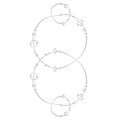Rational case
If f is a rational function
defined in the extended complex plane, and if it is a nonlinear function (degree > 1)
then for a periodic component of the Fatou set, exactly one of the following holds:
- contains an attracting periodic point
- is parabolic [1]
- is a Siegel disc : a simply connected Fatou component on which f(z) is analytically conjugate to a Euclidean rotation of the unit disc onto itself by an irrational rotation angle.
- is a Herman ring : a double connected Fatou component (an annulus) on which f(z) is analytically conjugate to a Euclidean rotation of a round annulus, again by an irrational rotation angle.
- Julia set (white) and Fatou set (dark red/green/blue) for with in the complex plane.
- Julia set with parabolic cycle
- Julia set with Siegel disc (elliptic case)
- Julia set with Herman ring
Attracting periodic point
The components of the map contain the attracting points that are the solutions to . This is because the map is the one to use for finding solutions to the equation by Newton–Raphson formula. The solutions must naturally be attracting fixed points.
- Dynamic plane consist of Fatou 2 superattracting period 1 basins, each has only one component.
- Level curves and rays in superattractive case
- Julia set with superattracting cycles (hyperbolic) in the interior (period 2) and the exterior (period 1)
Herman ring
The map
and t = 0.6151732... will produce a Herman ring. [2] It is shown by Shishikura that the degree of such map must be at least 3, as in this example.
More than one type of component
If degree d is greater than 2 then there is more than one critical point and then can be more than one type of component
- Herman+Parabolic
- Period 3 and 105
- attracting and parabolic
- period 1 and period 1
- period 4 and 4 (2 attracting basins)
- two period 2 basins





















